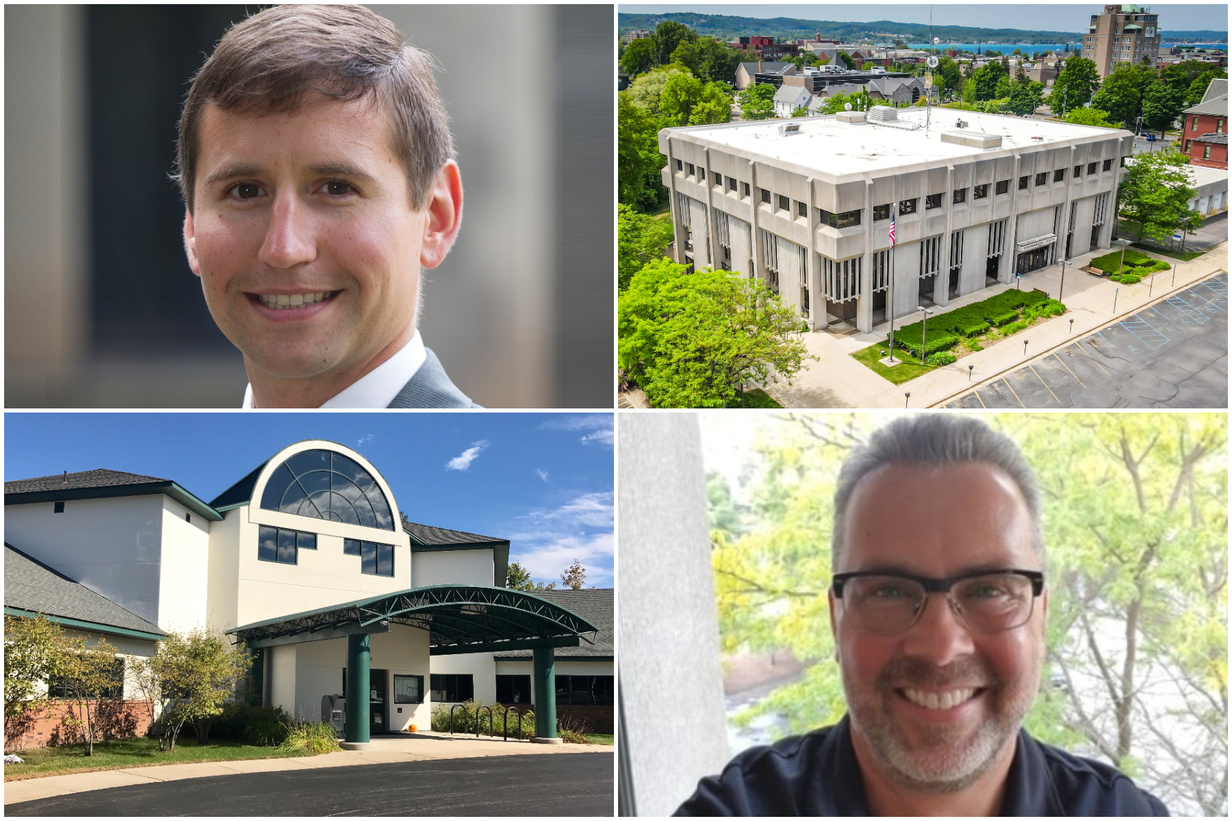
Planning For The Future: Shawn Winter And John Sych On Navigating Intense Local Growth
By Craig Manning | March 7, 2022
Traverse City is at an inflection point, between its small-town roots and a more metropolitan future. As the planners for the City of Traverse City and Garfield Township, respectively, Shawn Winter and John Sych not only have front-row seats to that inflection point, but are also arguably in the driver’s seat. With pandemic-era growth pushing the region into its next chapter, The Ticker sat down with Winter and Sych to learn how the Traverse City area will navigate its evolution gracefully.
Ticker: By untethering folks from their offices, the pandemic has triggered intense growth in northern Michigan. How top-of-mind is that growth as you’re looking at the future?
Sych: It’s interesting to note that both our communities are going to be undertaking master plan updates soon. In Garfield Township, the [current] plan was actually done and finally adopted in 2018, so it's really not that old. But we're starting the process this year to do public engagement, and then we'll do a formal update in 2023.
In terms of actual development, I’d say that, even in the early part of the pandemic, things were starting to pick up in terms of people moving into the area. We saw a lot of real estate activity, and in Garfield Township, we've seen a lot of proposals for multifamily development. Since I've been [in this job], we've only approved one subdivision – which has yet to be built – but we've approved a lot of apartments, a lot of senior living, attached condos; that type of thing has been moving quickly. Historically, there really hasn't been a lot of multifamily development [in this township], but that's the type of residential option that people are looking for, particularly when they're moving into the area.
Winter: Our master plan was adopted in 2009 and updated in 2017, and we have an RFP out right now for a complete rewrite. So that’s a process that's going to guide us with these issues in the future.
We, too, have had a lot of multifamily development. We permitted more [of those developments] in 2021 than any other year before, in terms of the number of total dwelling units. Some of those are paused because of lawsuits, and I think the lawsuits that we've had recently – about tall buildings – are tempering some of the developers a little bit. They’re being cautious until these appeal processes work through.
Ticker: What are the top challenges this area is facing?
Winter: Our top issue right now is housing. We need to find ways to increase the supply. At this year's Northwest Michigan Housing Summit, Charlevoix County’s planner presented county data about their number of housing permits, and [those numbers] are nowhere near what they were in the ‘70s. We're not building dwelling units as fast as we used to, and now we have even more people. So we have a supply-and-demand issue. and I think that's been complicated by the fact that many people have been untethered from their offices and are moving here. The person who bought the vacant house across the street from me works in Silicon Valley, but he's going to live here. He’s competing in the local housing market with Silicon Valley income, against everyone else.
There's another factor that we're starting to hear more in our conversations here at the Governmental Center, and that’s the climate refugees. I have someone just up the street from me, a couple who moved here from Park City because they just couldn’t handle the wildfires anymore. Again, both of them maintained their California jobs, but bought a house in Central Neighborhood. So that’s tipping the scales and making it hard [for locals] to invest in ownership.
We know we need affordable workforce housing, but it's difficult – between the cost of the land, the cost of construction and labor, and the taxes. It really doesn't pencil out [for developers]. The city, we’re not developers, but we can figure out how to get out of the way. We can ask: ‘What are some of the barriers that we've put up to housing that are making it harder for people who are willing and capable to build additional units?’
Sych: I came to this area in 2006 and took the job as planning director for Grand Traverse County, and I’ll always remember reading an article about Roger Williams, who was my predecessor. When he left in 2003, the Record Eagle asked him: ‘What's the most pressing issue in Grand Traverse County?’ And he said, ‘Affordable housing.’ So here we are 19 years later, and if anything, the issue has just grown.
Garfield Township has been trying its best in affordable housing. We’re looking at ways to allow for construction of single-family homes more in the starter home [price range]. We'll be looking at our zoning and ways that we can allow for smaller lots, and so forth. And we’re looking at multifamily and seeing how we can increase the density.
We’re also still getting quite a bit of commercial development: A lot of restaurants – mostly fast food – and a lot of discount stores. We've been fortunate that we've been able to replace some of the larger big box stores with discount retailers coming in. But when we look at the overall landscape of commercial businesses, we know we can’t rely [on those trends] to fill all the vacancies. We have to look at ways to mix uses.
For instance, we’re looking at the Grand Traverse Mall, and we’re asking, ‘How will they ever be able to repurpose themselves to incorporate, say, residential?’ I think we can do it through our zoning, to accommodate those types of mixed developments. But that’s where we really need to get back to our master plan and identify that vision, because every time we have discussions about changing our zoning, it's hard when you don't have a strong vision in the master plan. And right now, our master plan is weak on vision.
Winter: Our master plan also lacks a strong, cohesive vision. It's one thing that we're hoping to get out of the new one. We’ve also asked for a action plan component [to our plan], to give us direction. As in: ‘In order to get to this vision, these are the tasks that need to be done in the near-term, the intermediate, the long term.’
In addition to the master plan, we received proposals two weeks ago for a mobility and bike action plan. Just like Garfield Township with zoning, every time we do some sort of street project, there's no vision of an overall bicycle or mobility network. So then, we get in the trenches fighting about whether there should be a bike lane on this road, or a sidewalk. And then we end up with things like Eighth Street, where we have three blocks of great infrastructure that just dead-ends on either end and no one knows where it's going from there.
What we're trying to do, in terms of regional sustainability and connectivity, is think about how our mobility plan is going to connect to the Garfield plan and the other regional trail systems, so that you really have a non-motorized mobility network. We’re not just an island in the city; there's plenty of existing trails in Garfield, Elmwood, East Bay, and beyond that all need to feed in and work together.
[That mobility] is a big part of resiliency through tough economic times. When gas prices are getting up there, and spring is coming around the corner, people are going to start biking more. It can also relieve some of the pressure on our transportation network. Now, one of the problems we had with our transportation network last summer was the sheer volume of work that we had going on. But that's going to continue for the next few years. In 2022, we have two more bridges being worked on. In 2023, we have Grandview Parkway, from Division to Garfield. In 2024, we have from Division to Cherry Bend Road getting redone. So, it's going to be challenging, and it may force people to think about transportation options.
And beyond those planned projects, I think – with the infrastructure money we see coming down the pipe, and with the ARPA funds – there's going to be even more projects, things that aren’t planned and programmed right now. New opportunities are going to come up, and hopefully we're using those funds to make a more sustainable community for the future.
Ticker: Many people in our community believe we will need to ‘build up, not out’ to support growth. Where do you see this debate leading?
Winter: One issue is that our downtown really can't grow out. It's surrounded by historic neighborhoods and the bay, so up is the only way to go. I think we'll eventually reach a point where this issue, of Proposition 3 and building height limitations, is going to be revisited by the community. The need for housing is going to keep increasing, and we’re going to have to go up to accommodate that.
I have noticed a shift in the tone of the community conversation. There's more frustration now with Prop 3 than there had been. People are seeing what they felt were good building projects – projects that were providing a lot of housing – being stalled by this.
Sych: As we’re talking about either building up or building, one of the concerns is: If we build out, what does that look like? One of the things we’re trying to do [in Garfield] – and we don't currently have it in our plan, but I hope to see it added – is create actual places. Downtown Traverse City is a great place. How do we emulate that and create other smaller places that have the same feel?
We’ve been working on the redevelopment of Cherryland Center. I like that area, because there's about 40 acres of land that could be redeveloped to create some type of walkable environment. But it's also connected to the city in terms of its grid system. We have Woodmere, Barlow, and Garfield all coming down there. If we created some kind of town center there, that could connect well to locations in the city.
Another area that we're looking at is West Front Street, over by Olesen's grocery store. That area is predominantly office, but there might be opportunity to incorporate multifamily residential and start creating some sidewalks, some other infrastructure, maybe have some places where all those office workers can have lunch.
Winter: The last city I lived in in was Richmond, Virginia, which was 63 square miles. Within that 63 square miles, you had multiple locations that were like what our downtown is. We had other nodes of activity with commercial mixed use and housing. I think what John's getting at is: We don't need all our emphasis regionally on downtown.
Even at the city, we’re looking at other places. We see what’s happening on Eighth Street; we're looking at the Garfield Corridor; we’re looking at the 14th Street corridor. But the next thing you know, we're bumping into John's jurisdiction. And historically, I don't know that there's been great regional collaboration on these heavier issues. Each jurisdiction likes its identity and likes operating by itself. It's not that they're not willing to [collaborate], but it seems like there's some friction there.
Sych: I think, as planners, we can obviously see the connection and how these things work together. But we're also responding to elected leadership, and that’s where I think the friction is.
Winter: But there's evidence of it working well. I think the Commons is a great example of jurisdictions working together on a heavy project. It probably would have been easier to walk away from the Commons, compared to all the work that had to be put into it. And that’s not to minimize the fact that there was a tremendous amount of private work put in by the Minervinis. But our two jurisdictions worked together in good faith there.
My comment earlier about ‘friction’ isn't necessarily a slight at any one jurisdiction, or the elected officials. I think some of it is a byproduct of our government structure here in Michigan – with cities, and townships, and villages, and counties. It’s just layer upon layer, and everyone has their constituents that they’re representing. It's not a system that I feel is set up for effective regional collaboration.
Ticker: What's the biggest change local residents can expect to see in the next 10 years?
Winter: Looking into 2032, we're going to see more people and we're going to see a continued demand for housing. It hasn't waned in the last 20 years. Hopefully, we'll get more creative in how we address that. But I think with that growth, we're going to see more opportunity. I'm encouraged by the fact that we're having younger professionals with new ideas moving into the city, and I hope that’s going to lead to better economic opportunity. We’re going to have new entrepreneurial ideas and businesses opening up, and it's going to diversify our economy. With that, we become a little more balanced. We're not just a retirement community that has a lot of service industry workers. We have people from all levels of professions, skills, and incomes, all able to live here and call this area home.
Sych: I think we're going to see housing in places we didn't expect before. We're going to see a lot more mixing of uses. Historically, we’ve divided uses – residential here, commercial here, industrial here. We don't have that luxury anymore, to be wasteful in how we develop. We need to be more efficient, and that’s forcing people to get creative in design and development. Like Shawn said, [our jurisdictions] don't do the development, but we can help to steer it and guide it in a way that that benefits all the people in the community. I think we're going to want to encourage that innovation, toward development and creativity in mixing uses together. Which, ultimately, I think is going to make a better quality of life.
Comment






